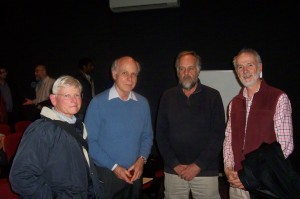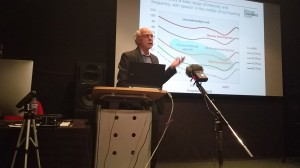Meeting Report
Technologies for Hearing and Listening
Presented by Prof Peter Blamey
On Monday 6th June, Prof Peter Blamey Executive Director of Blamey Saunders Hears presented to us on the topic “Technologies for Hearing and Listening” covering the principles and technologies of modern hearing aids, and providing insight into the innovations developed by Prof Blamey and his team.
Peter started by displaying a family of SPL/Frequency graphs describing the levels of hearing impairment which are usually described as mild/moderate/ hearing loss.
He then launched into a brief history of assisted hearing devices, displaying photos of some ingenious acoustic devices ranging from King Goa of Portugal’s “hearing chair” from 1819, through multi-directional table-top horn systems, an acoustic walking stick, and a range of more traditional ear trumpets.
Peter then covered early electronic hearing aids, from Michael Hutchinson’s original 1901 Akoulallion through to the first transistorised models.
He then described how hearing aids went digital in the 1990s, using tiny computer chips which engineers can program.
A basic system block diagram of modern digital devices was displayed, and Peter commented that the advent of digital systems, with their inherent latency introduced a new challenge with delay having to be minimised.
He then described the use of open platform chips like Ezairo 7100. He showed its block schematic and described the external parts required – mics, speakers, telecoils, and batteries.
He emphasised the need for good A/D converters, mics and speakers, as well as excellent engineering to combine all the parts into a modern hearing aid.
He made the surprising statement that it’s only been in the last 15 years that hearing aids have become better than the older acoustic ear trumpets. Indeed, he said, modern developments mean electronic hearing aids can finally surpass the old ear trumpet’s performance.
He then spoke on developing algorithms, and their importance in the modern hearing aid.
He introduced ADRO – Adaptive Dynamic Range Optimization, and described how it has outperformed the older Wide Dynamic Range compression in clinical trials.
Peter recounted how he and Elaine Saunders pioneered the use of a modular software architecture, so one of the functional elements within a hearing aid chip could be changed without changing all the others. This dramatically reduced the tooling costs of updating algorithms.
He explained that ADRO utilizes 64-128 channels compared to a previous maximum of 8 (typically only 1-2).
Despite industry scepticism, clinical trials demonstrated that it worked better than a top-of –the-range 8 channel traditional device.
He described how those clinical trials were conducted, and then described the operation of ADRO
He followed this up with a description of the development of adaptive directional microphone technology to improve sound pickup – using the power of the device’s DSP.
This had the effect of improving listening in the presence of background noise and in reverberant spaces.
He then noted that feedback-generated whistles have been an issue with electronic hearing aids, and described the operation of the feedback canceller developed by Freed and Soli (2006).
He concluded by commenting that Digital Signal Processing in hearing aids opens the door for a whole range of things that were not possible without digital technology.

A wide-ranging question and answer session followed the presentation.
A video has been assembled of the talk, covering the Powerpoint slides+audio, and video inserts:
This video can also be viewed directly on YouTube at https://youtu.be/va2uKh6aXmU
The slides only as a downloadable PDF can be accessed here.
-and-
The audio-only recording can be heard or downloaded here.
Thanks to Graham Haynes and his trusty Tascam for the audio recording, and
a special thanks to the SAE Institute for allowing us the use of their fine facilities.

